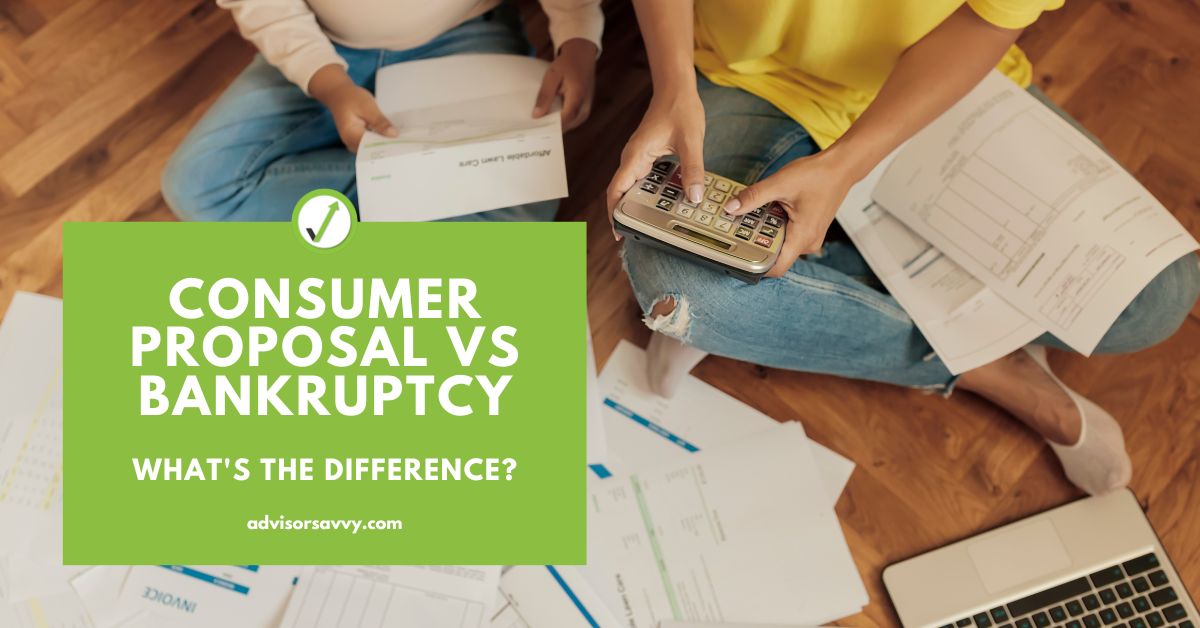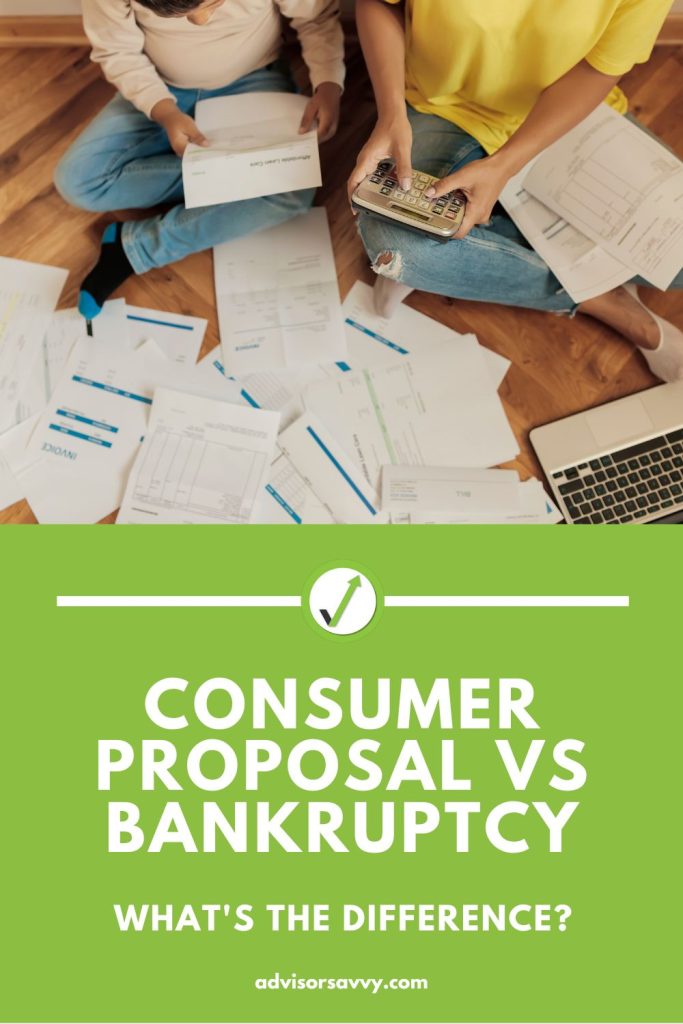
When debt gets to unmanageable levels, Canadians usually have two options to eliminate their debt. The first is a consumer proposal and the second is a bankruptcy. Both options have a lot of similarities, but also many differences. In this blog post, we will compare and contrast consumer proposal vs bankruptcy, so that you can make an informed decision about which option is right for you.

Table of contents
Consumer proposal vs bankruptcy
In Canada, personal bankruptcy and consumer proposals are two debt relief options. A consumer proposal entails legally binding terms between you and your creditors. The agreement stipulates how much is owed and when it is to be paid. If you cannot pay your bills when they are due because of economic hardship, you may file for bankruptcy instead. Let’s learn more about consumer proposal vs bankruptcy below.
What is a consumer proposal?
A consumer proposal is a legal agreement between you and your creditors. It is handled by a Licensed Insolvency Trustee (LIT). This is a professional who helps you negotiate the terms of your debt repayment. The contract stipulates you will pay part or all of your debt at a reduced rate over a specified time period.
This legally binding agreement will protect you from debt collectors and stop wage garnishments. Your interest on your debt will also stop accumulating the day you file. The only requirement is to follow the consumer proposal plan as agreed upon with your creditors.
What is bankruptcy?
Bankruptcy is a legal procedure that completely frees you from all debt. A Licensed Insolvency Trustee will be assigned to your bankruptcy case to manage your assets (with few exceptions), investigate your situation, and keep track of your bankruptcy obligations. Generally speaking, bankruptcy involves you surrendering all assets, liabilities and other aspects of your finances. Your LIT will handle the process from there according to bankruptcy laws. In exchange, you will leave the bankruptcy free of debt.
If you fulfill the legal bankruptcy responsibilities, which include attending two credit counseling sessions and submitting monthly reports on your income and expenses, you will most likely be relieved of your debt in 9 to 21 months.
Is a consumer proposal considered bankruptcy?
No, a consumer proposal is not considered bankruptcy. Although there are some similarities between the two processes, a consumer proposal is intended for a very different purpose. The main similarity is both consumer proposals and bankruptcies are legal proceedings. They must be executed with the assistance of a Licensed Insolvency Trustee. Otherwise, both processes are unique.
Unlike bankruptcy, which typically involves significant debts and tight time constraints, a consumer proposal is designed to provide relief to individuals who are struggling with more manageable amounts of debt. In addition, a consumer proposal does not involve total liquidation of assets. It can help to preserve credit and prevent foreclosure or repossession. Debtors still repay a portion of their debt through a consumer proposal as well. Whereas bankruptcy doesn’t necessarily involve repayment of debt.
Does a consumer proposal show as bankruptcy?
No, consumer proposals and bankruptcies are not the same. Therefore, on your credit report and public record, a consumer proposal would not appear as a bankruptcy and vice versa.
Related Reading: What Is Debt Consolidation?
Main differences between consumer proposal vs bankruptcy
There are several important differences between a consumer proposal vs bankruptcy. Understanding these differences is critical in making an informed decision about which option is best for you. The most significant difference is that filing a consumer proposal will have far less of an impact on your credit score than filing for bankruptcy.
Here’s a look at the main differences between consumer proposals vs bankruptcy.
| Consumer Proposal | Bankruptcy | |
| Requirements | The maximum amount of unsecured debt (excluding mortgage) is $250,000 | The minimum amount of unsecured debt is $1,000 |
| Cost | A negotiated settlement, which is usually 20% of your debt and paid out over a period of months | Based on your average monthly income, you are required to make monthly payments |
| Time scale | Up to 5 years, there’s no penalty for early termination | Depending on how much income you earn, you may be required to wait 9 or 21 months |
| Reporting | There are no monthly reporting obligations. | Reports on budget and income are required monthly |
| Impact on credit | A consumer proposal will stay on your report for 3 years after finishing the program, or 6 years after filing — whichever occurs first | A bankruptcy will remain on your credit report for 6 to 7 years after you are discharged. |
| Impact on assets | It protects your assets and keeps them separate from the agreement your LIT negotiates with your creditors | You must surrender all non-exempt assets |
Helpful Tool: Savings Calculator
Debt relief: Consumer proposal vs bankruptcy
There is no easy answer when it comes to deciding whether a consumer proposal or bankruptcy is the better option for debt relief. It really depends on the unique circumstances of each individual debtor. However, there are some general things to consider when making this decision.
For those who have a steady income and manageable debts, a consumer proposal may be a better option. This is because a consumer proposal allows you to negotiate a repayment plan with your creditors that is more affordable. It can feel good to repay a portion of your debt and this path is generally perceived as a better way to eliminate debt. In addition, a consumer proposal will have less of an impact on your credit score than bankruptcy. Finally, you do not need to surrender your assets in a consumer proposal. This means you can walk away from the situation with your home, car and other big ticket assets.
For those who are struggling with high levels of debt and little income, bankruptcy may be the better option. This is because bankruptcy allows you to discharge most or all of your debts, which can provide much-needed relief. However, it should be noted that bankruptcy will have a significantly negative impact on your credit score. Also, you essentially surrender all control of your personal finances during bankruptcy which means you could walk away with nothing — which includes no debt.
Related Reading: How to Improve Your Credit Score in Canada
Is a consumer proposal better than bankruptcy?
There is no one-size-fits-all answer to the question of whether a consumer proposal is better than bankruptcy. In some cases, going through bankruptcy may be the most appropriate option, while in others, a consumer proposal may be a better choice. Ultimately, the decision depends on a variety of factors, including the individual’s financial situation, their level of debt, and their overall goals for handling debts.
A consumer proposal may be the better choice for individuals who are struggling with high levels of debt but still have some sources of income available to them. These individuals will likely be able to make monthly payments towards their debts as part of a consumer proposal without compromising their ability to meet other financial obligations such as rent or mortgage payments and basic living expenses. Additionally, this approach will typically have less negative impact on an individual’s credit score than bankruptcy would.
For those individuals with very little income or assets and significant debt, however, going through bankruptcy may be the more sensible option. This process frees them from many types of debt and gives them a fresh start so they can focus on rebuilding their finances and regaining financial stability. While bankruptcy can be an emotionally challenging process that requires some sacrifice in terms of one’s assets and credit standing, it can provide much needed relief to those who are overwhelmed by debt and unable to pay it off in any other way.
Ultimately, deciding between consumer proposal vs bankruptcy involves taking into account all aspects of your personal situation in order to find the solution that best meets your needs.
What is worse bankruptcy or a consumer proposal?
In general, bankruptcy is perceived as more severe than a consumer proposal. However, sometimes bankruptcies are necessary to free yourself from debt. In addition, bankruptcies may be more practical depending on your level of debt.
Related Reading: Canada Debt: How much is too much?
Consumer proposal vs bankruptcy: final thoughts
When considering a consumer proposal vs bankruptcy, it is important to understand the benefits and consequences of each option.
A consumer proposal can be a less damaging option for the debtor’s credit score than bankruptcy and can allow the debtor to keep certain assets, such as a home or car. However, a consumer proposal can be more expensive in the long run than declaring bankruptcy and may not be available to everyone.
Declaring bankruptcy is an option that offers immediate protection from creditors and can provide a fresh start for the debtor. However, declaring bankruptcy can have negative consequences for the debtor’s credit score and can result in the loss of certain assets.
In conclusion, when considering a consumer proposal vs bankruptcy, it is important to understand the benefits and consequences of each option. Whichever option you choose, be sure to learn from your mistakes and focus on building a better financial future!
Read More: Budgeting Tips For Canadians

